Hands-On Look At Shimano’s Action Camera, the CM-1000
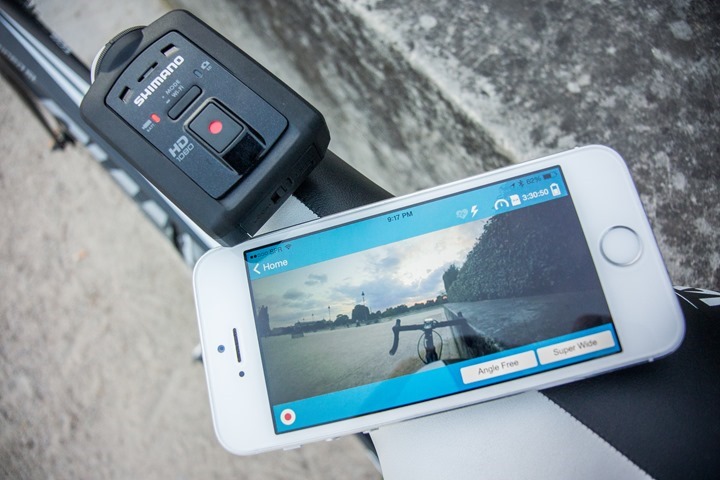
A few days ago the Shimano CM-1000 action cam that I bought finally came in. After getting some hands-on time with the unit I wanted to give some initial impressions and thoughts. The camera is unique in that it connects to ANT+ sensors (i.e. heart rate, cadence, power, etc…) and Shimano Di2 systems, while also being very small and fully waterproofed. The camera gained a fair bit of fame back at the Tour of California for some awesome sprint shots from the peloton.
This post isn’t in lieu of a full in-depth review. That’s coming later this summer once Shimano releases the rest of the system. Right now they’ve only released the action camera, but not any other cycling mounts nor the critical software required to actually get all the cool sensor data (aka: the reason you’d actually buy this camera).
Nonetheless, I figure this post will serve a few purposes. First, it’ll give you some of my initial thinking on the unit. Second, it’ll give folks a good discussion area to talk about experiences with the unit. And third, maybe Shimano will heed some of my posted suggestions in time for my final review later this summer. Though, I’ve never had any discussions with them, so no promises there.
With that, let’s dive into things.
What’s in the box:
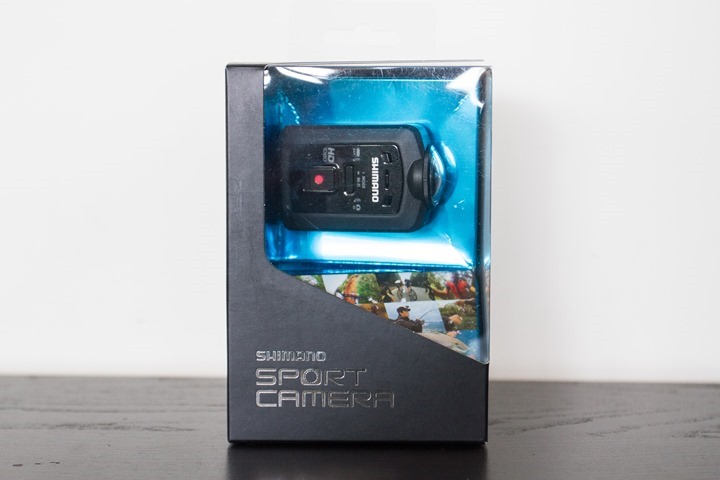
Inside the CM-1000 box you’ll find a large stash of papers, along with the camera itself, a second lens, a micro-USB cable, and a helmet mount. There’s also a small super-thin lanyard that can be used to ‘save’ the camera should it fall off of a mounting system.

I’ll dive into the mounts in a moment, so hang tight there. As for the camera itself, the small unit features two buttons – one larger button on top to start/stop recordings, and one smaller button slightly forward of the larger button that triggers changing of modes and enabling features.
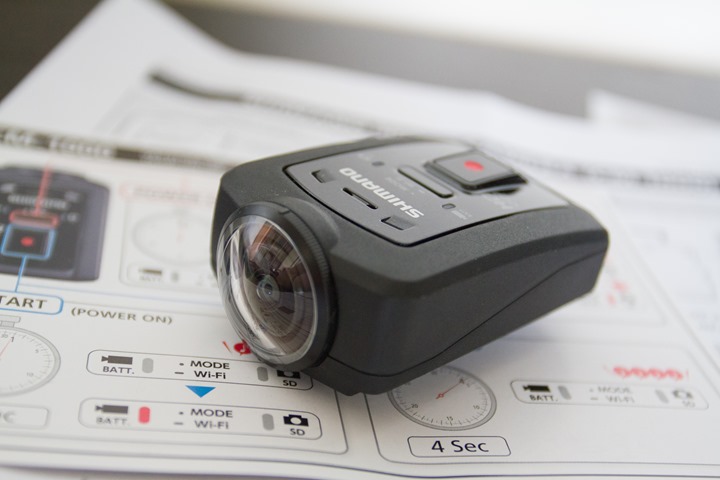
All of this is explained in the plethora of papers that accompany the unit. Unfortunately, Shimano seems to have taken a book from other bike component parts with massive fold-out papers that feature lots of warning text and little useful information.
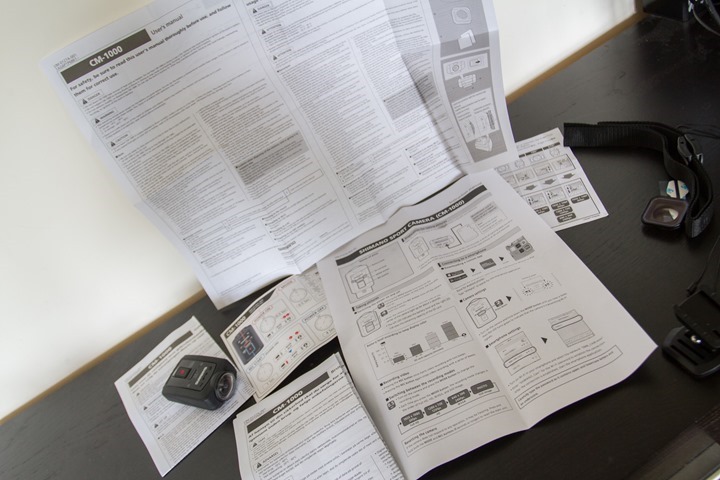
There is however a card with some color on it – this card is one that you’ll need to hold onto. Do not lose it. It’s your road map for operating the labyrinth of colors and buttons that control the unit. Realistically you should memorize it, but failing that I’d suggest zip-tying it to your handlebars. Duct taping it to the top of your helmet is also fully acceptable. Forsake aero for functionality, do not leave home without it…you’ll thank me later.
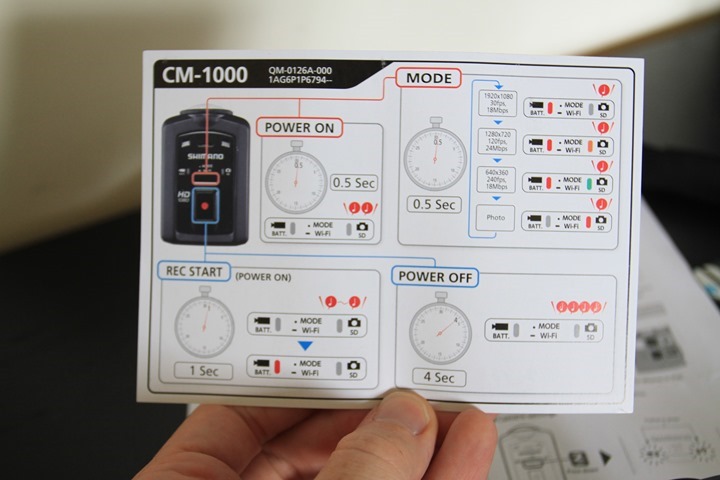
With everything unpacked, let’s dive into how big the CM-1000 is.
Size Comparisons:
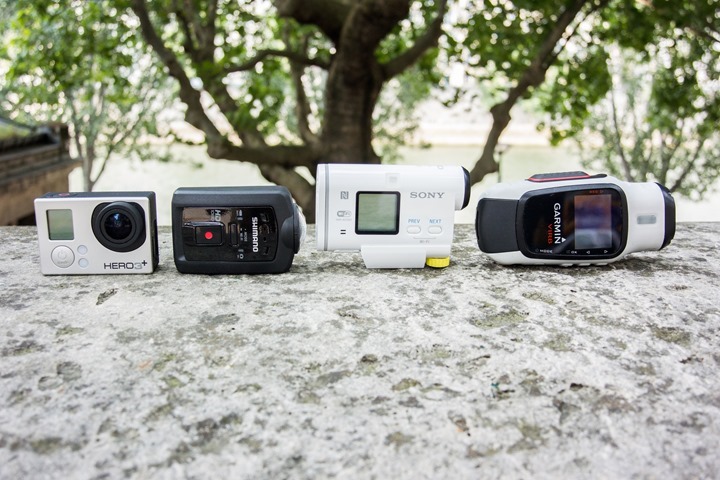
Size in an action camera is important – after all, you don’t want to be lugging around something large, or something that gets in the way. Size also impacts mounting options, both where you can mount it and how you can mount it. In the case of the Shimano CM-1000, it’s actually very small. It’s just a itty-bitty bit larger than the GoPro Hero3+. But it’s certainly the smallest camera that’s fully waterproofed (which the GoPro requires an external case for).
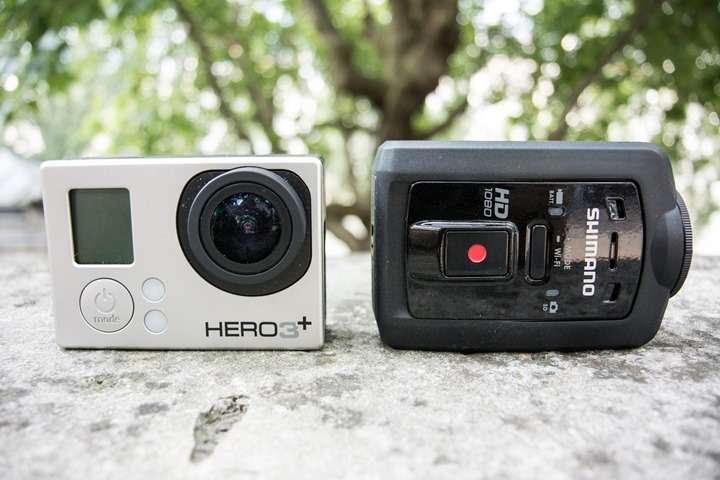
The VIRB is no doubt the largest camera out there, though, it does have more functionality in terms of things like GPS and a removable battery (which the Shimano unit lacks). The Sony HDR-AS-100V sits in the middle size-wise, as well as functionality wise in terms of having GPS but lacking sensor support. Still, size does matter when looking at the two extremes:
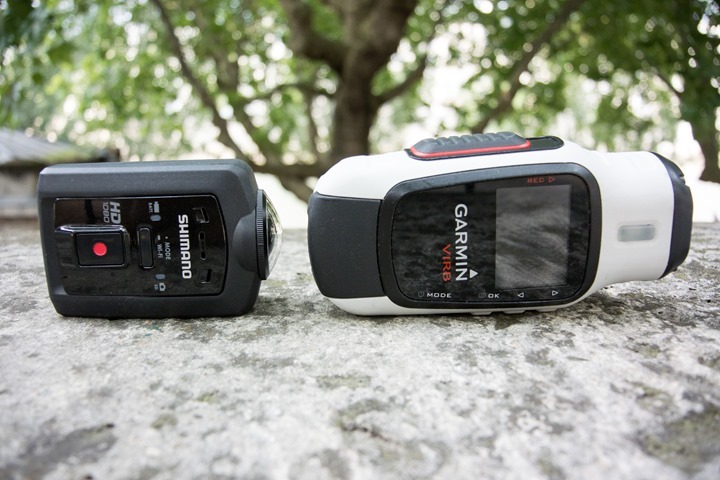
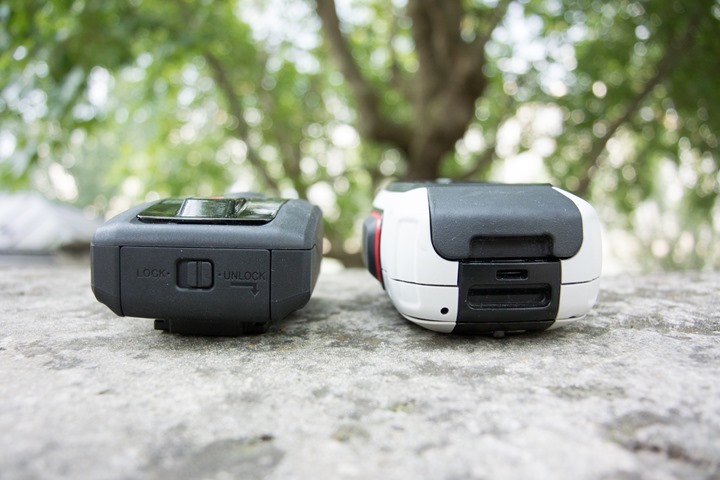
From a weight perspective, they weigh in at:
Garmin VIRB Elite: 180g
GoPro Hero3+ Black: 73g
Shimano CM-1000: 86g
Sony HDR-AS100V: 67g
Each of these were weighed as a base unit. It’s a bit tricky because there’s always some form of mounting required that will increase weight. But since those mounts vary based on what type of mount and what person (i.e. helmet, bike, etc…), I’ve left them off for now.
Getting it mounted:
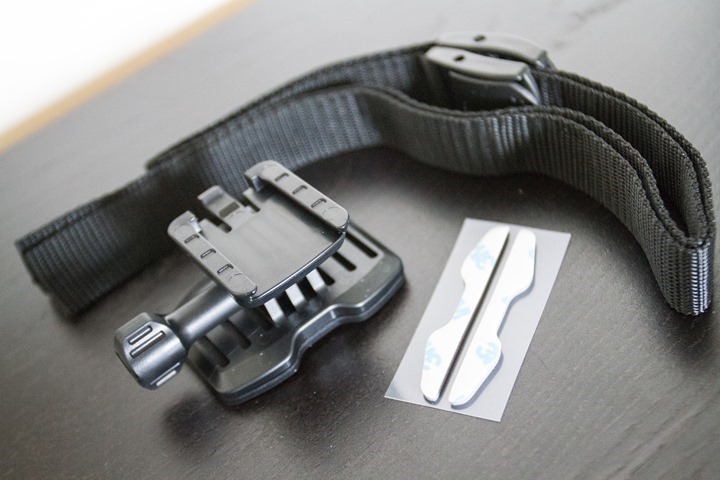
When it comes to mounting, Shimano has currently left us in a bit of a gap. The unit comes with a helmet mount (seen above) that allows you to strap that to your head and then the camera to the mount.
But that’s basically all Shimano has today. It doesn’t yet have any other mounts for your bike, and otherwise only has a chest and hat mount
The problem with helmet mounts is that nobody actually uses them in road cycling. It’s simply a sucky place to put an action camera. For mountain biking and other sports it makes more sense, but in road cycling you tend to want a much more stable platform to get better video (and your head is not that platform). Don’t get me wrong, there’s an occasional situation where a helmet-mounted camera video works outs – but in general the footage is rough.
There is a bit of good news here though. It starts with the fact that Shimano went with a GoPro mount. Or said differently, Shimano apparently has beach balls made of steel – willing to just blatantly copy the design. Which, to be fair, I’m totally down with in this case.
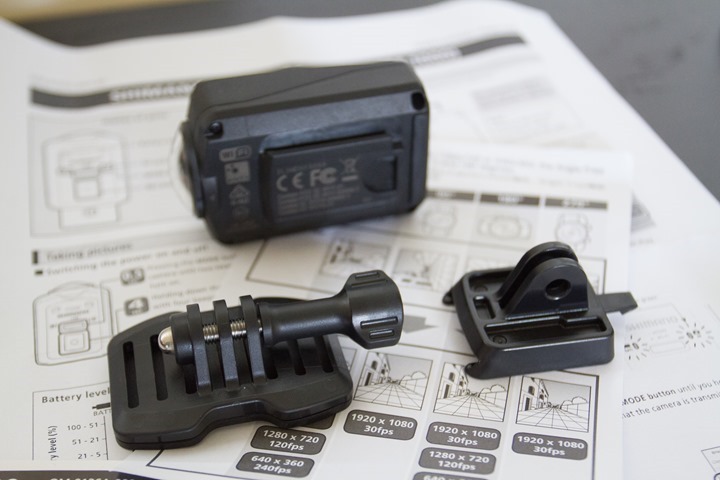
See, most companies will make a GoPro ‘adapter’, which means that you can mount their action camera to a GoPro mount using a small adapter. But said adapter isn’t the primary mounting method. Garmin takes that route for example.
In the case of Shimano – this is the primary mounting method. Now I’d expect that they could technically argue in court that the camera itself has a slightly different mounting plate to the main mounting adapter. But it’s all semantics. But that’s OK, I’m happy to ignore that.
Why’s that?
Because it means the world is my oyster mount-wise. In fact, in my large arsenal of action cameras, it’s always the wonky-ass and craptastic mounts of other companies that put me off so much. So in this case, I can just use any GoPro mount, of which there are hundreds.
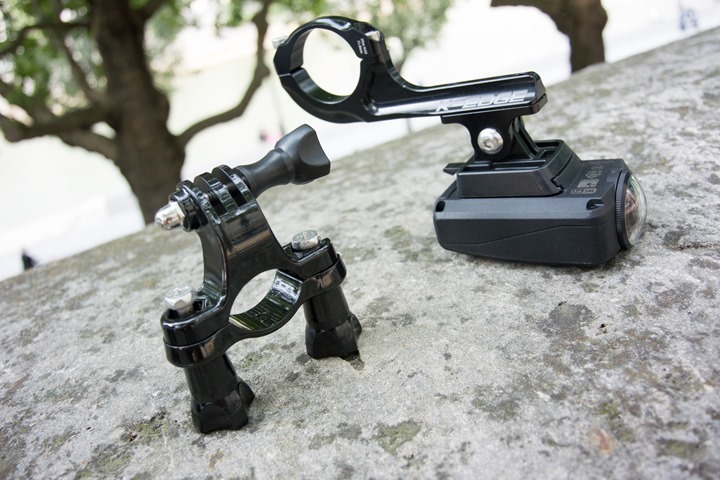
For road cycling (or really, any bike mount scenario), my favorites are the K-Edge ones. They are slightly pricey, but they give rock-solid video results. If you look at some of the Pro Teams in the TdF using mounts, they’re generally using K-Edge ones as well. It also helps that I can buy them at the store behind my house (I’m lazy like that).
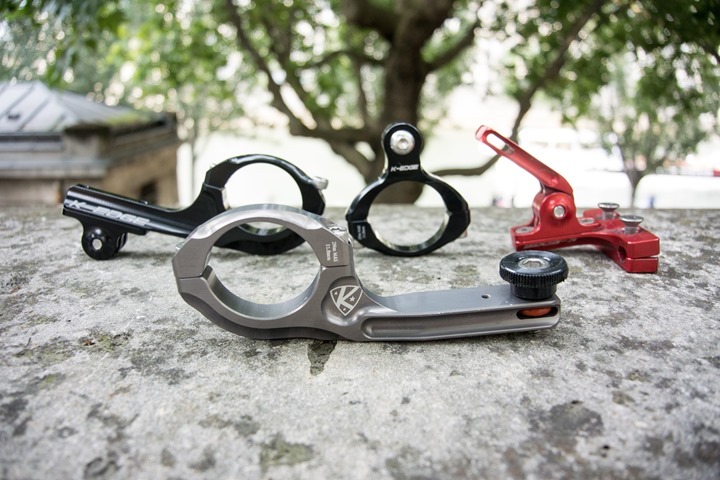
In the case of the Shimano action camera, it’ll directly attach to any of the GoPro K-Edge mounts, or indirectly mount to any tripod mount (aka ‘universal’ mount) as long as you have the cheap $9 GoPro Tripod mount adapter. I always have a few of those around because I never know what I’ll want to mount it to (like this cheap little tripod I use while travelling):
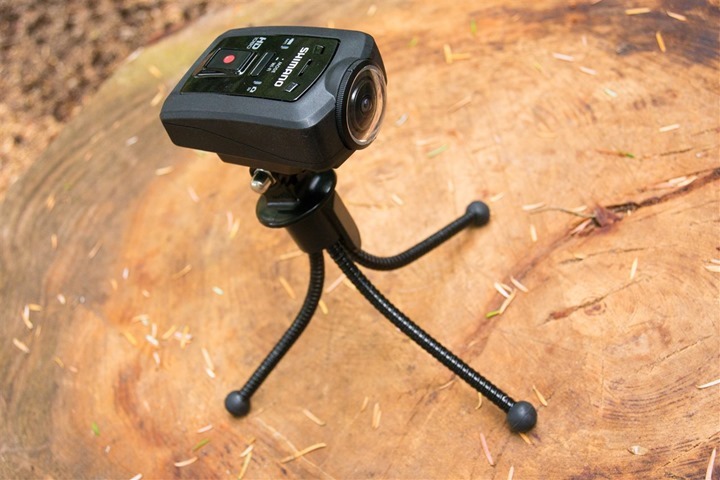
So in my case, I’ve mounted it using the above mounts to two places on the bike. First up is a forward mount under the handlebars.
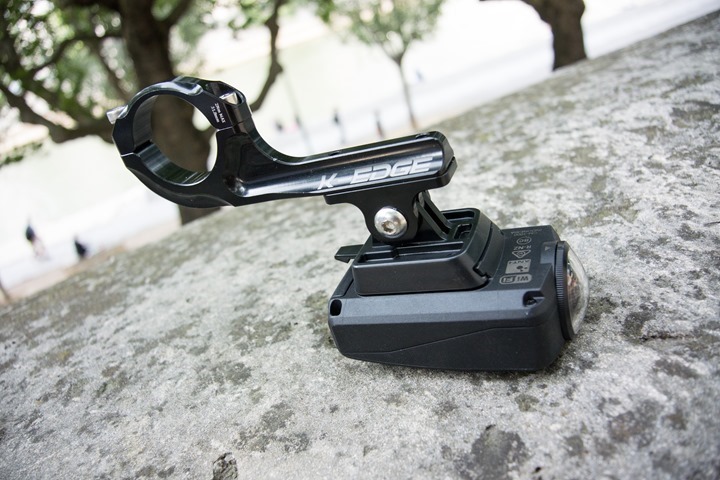
Most people go under the bars because it makes the camera less obvious and less unsightly:
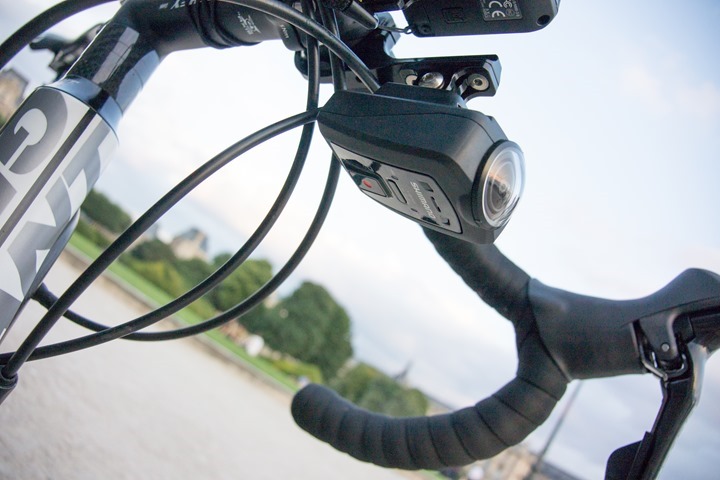
The second spot is on a rear mount under the seat post facing backwards:
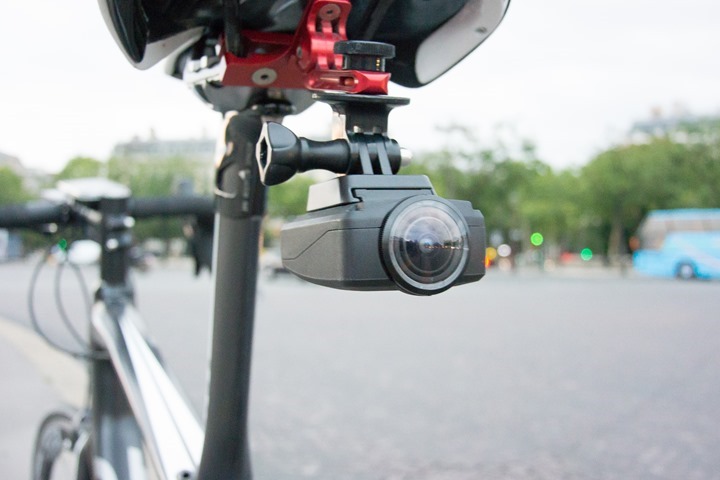
The one thing you’ll notice here is that the Shimano unit really does a much better job blending in than other action cams. I suspect it’s because it sorta looks like a rear/front light, so you don’t quite notice it as much.
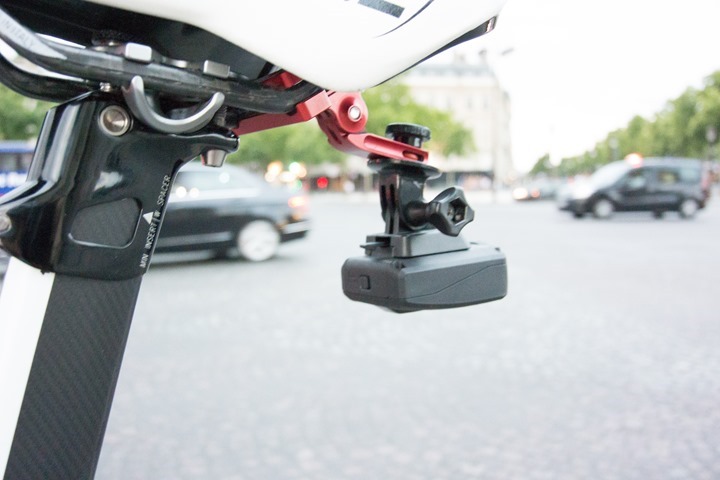
With everything mounted, let’s get onto finally using it.
Usage:
Now that you’ve got it all mounted up it’s time to use it. To power it on simply press the smaller button briefly, which powers the unit on.
From here you can press the same button further times to iterate through different modes. These modes are all documented on the card that ‘ye shall not lose’.
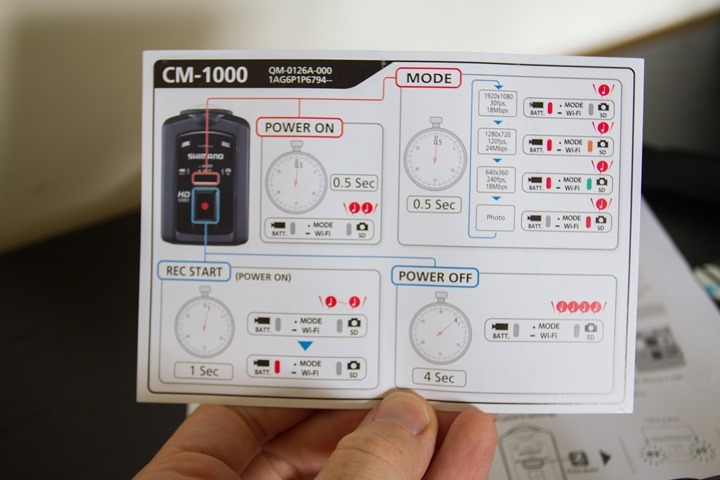
Oh, and don’t forget the back of the card, as that has more critical information.
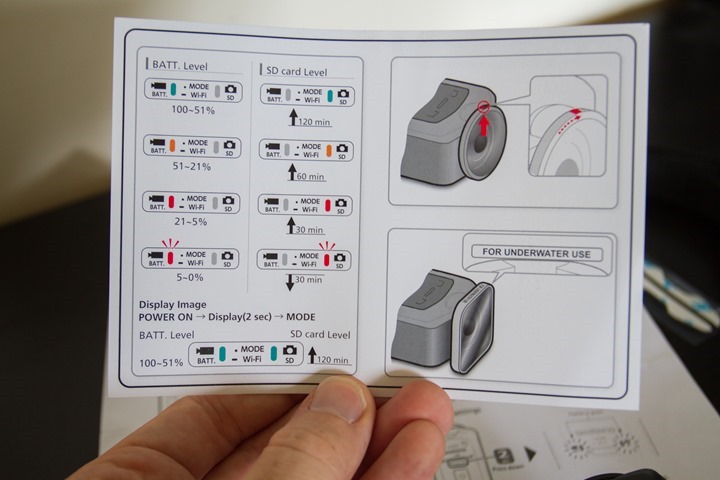
And this is where my really singular problem with the unit comes in: It’s confusing as heck.
See, Shimano opted for only two lights on the unit. All status information comes from those two lights. You have to effectively memorize the entire combination of these two lights in order to understand what’s going on. And while you may think you know what the current battery and SD card state is – that doesn’t actually tell you what mode you’re in by just glancing at it.
For example, you could be in still photo mode, or ultra high speed photography mode. You wouldn’t know – and that’s on a good day standing there in a green grassy park on a nice sunny afternoon. Try that on a miserably cold and rainy winter day roadside leaning over your bike.
Which, brings me to the second issue (ok, I guess I have two significant issues): It’s not easy to tell if the unit is currently recording. While the unit will blink the second light (and a specific audible chirp), that light is only in a single place on the top of the unit. Since most bike positions will have the unit upside-down it’s not something you can quickly glance at. And, since it’s a small light that alternates slowly like a lighthouse, it’s easy to miss. So you find yourself doing this a lot:

I should mention that to start recording you’ll simply press the big recording button – which is easy to find:
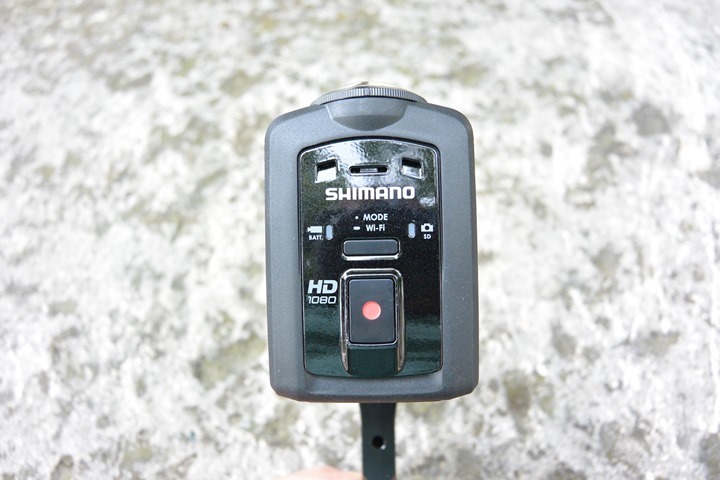
Alternatively, you can trigger the unit from the app – but I’ll cover that in a few sections.
As part of the modes you can set it to, you can also capture still photos from the unit. There are two options here. The first will capture a single still photo at the point in time that you specify. Whereas the second will go into an interval mode, which captures photos at a preset timeframe – including: 10s, 20s, 30s, and 60-second modes.
Now, the Shimano is unique in that unlike the GoPro it’s fully waterproofed (according to the manual) to a “JIS waterproof grade 8 (IPX8)” that can be used at “depths of up to 10 m (approx 30ft) for up to 2 hours”. That’s far better than many of the other action cams that are lightly waterproofed. The GoPro is not waterproofed without the plastic case that it comes with.
Interestingly, the manual does state however that the CM-1000 is only waterproof “against seawater and fresh water”, which gives me slight pause if that’s attempting to exclude chlorinated pool water, or if that just means not do dunk it in a stein of beer. Hopefully I can get Shimano to clarify there.
Shimano rather nicely does include a separate underwater lens with the unit.
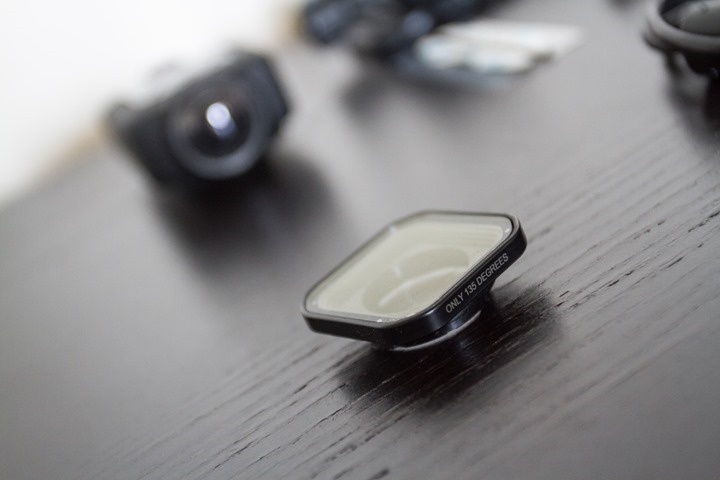
The purpose of this lens is not to increase waterproofing, but rather to simply ensure that the unit can focus underwater. Like most action cameras, without this lens the unit will constantly be out of focus underwater. It’s the reason why all the action camera dive cases have flat lenses and not curved lenses.
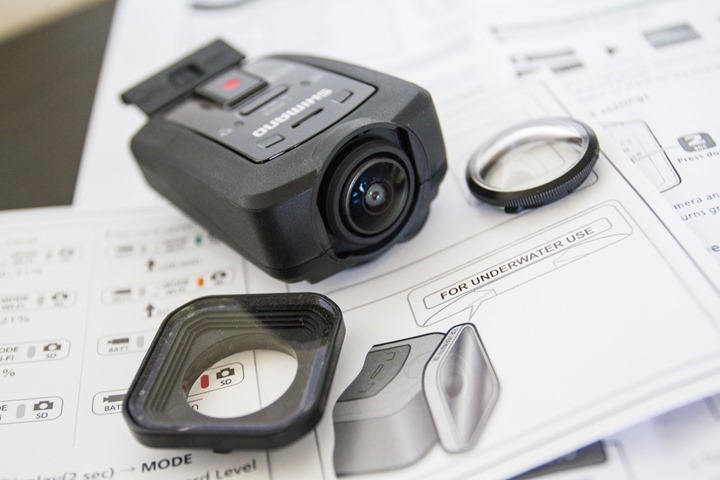
To install it you’ll simply twist off the old lens and twist this one in place. It only takes about two seconds.
Next, we’ve got what is my favorite feature to date: Angle Free.
This feature means the camera will automatically rotate the image in the unit itself based on how you’ve mounted it. For example, if you’ve mounted it upside-down the unit will automatically rotate to compensate for that. If you’ve mounted it at a 90° angle, the unit will flip to that too. Below you can see how I have the unit at 90°, but the video is straight.
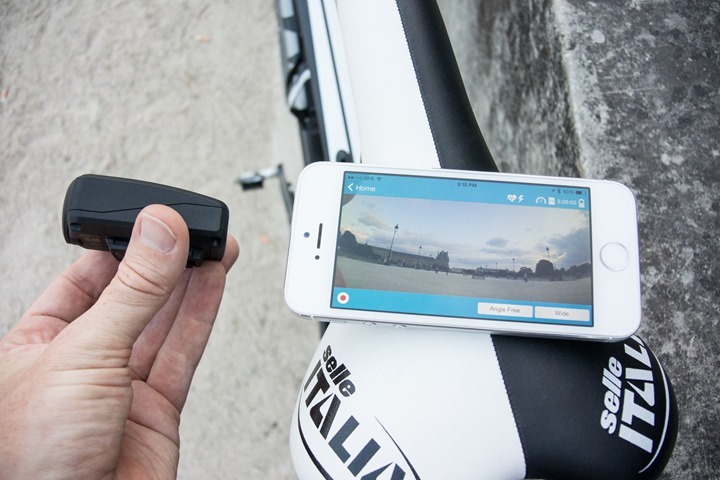
This prevents you from recording an entire video upside-down and not realizing it. Of course, you can turn this off if you want to – in the event you’re doing backflips on your mountain bike. I’d suggest however if you’re doing backflips on your road bike…you’re probably in a bad spot.
To see this in action, I’ve put together this short little clip:
With that we’ve covered all the features to date that can be controlled natively from the unit itself. Now let’s dive into the sensors as well as the mobile phone driven functionality.
ANT+ Sensor Pairing:
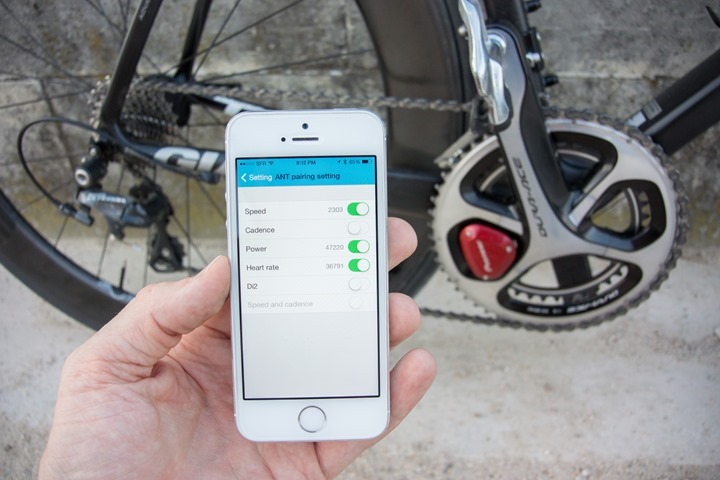
The Shimano Action cams becomes the second camera on the market (behind the Garmin VIRB) to include ANT+ sensor integration. This means that you can get details like power, heart rate and cadence from compatible ANT+ sensors. This information can then be displayed on the screen down the road once Shimano releases their desktop editing software.
To pair sensors you’ll need either the iPhone or Android app. This app will connect via WiFi to your camera. Once that does that you can then dive into the settings menu and then the ANT sensors menu to start pairing:
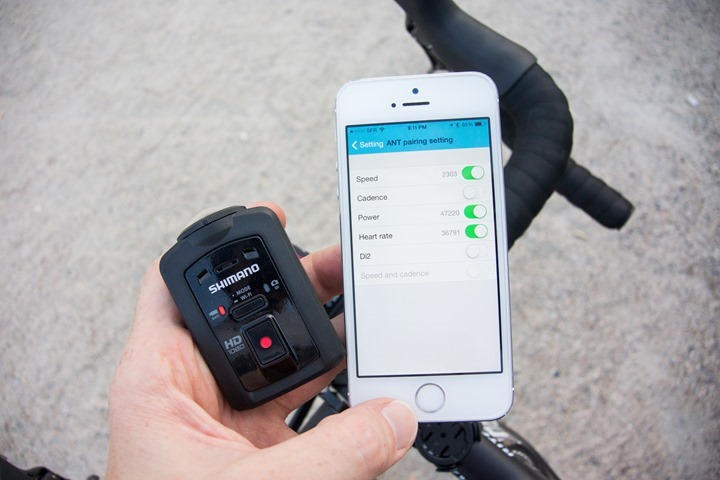
Here you’ll iterate through each of the supported sensor types to toggle it on/off and initiate pairing.
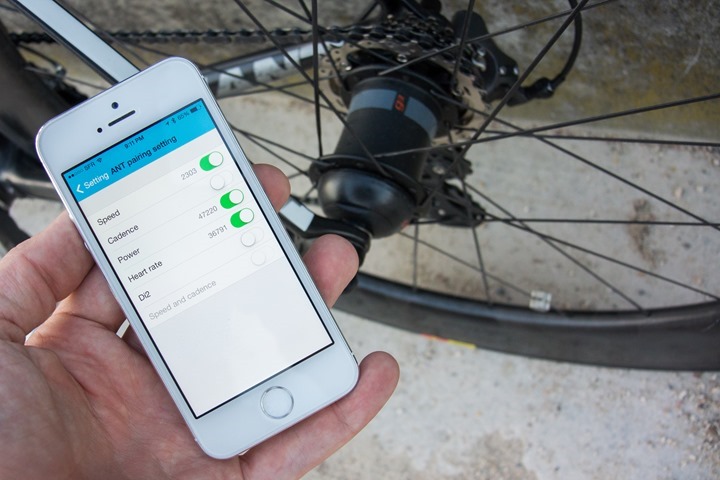
When it finds a sensor it’ll save the sensor device ID and display it next to it:
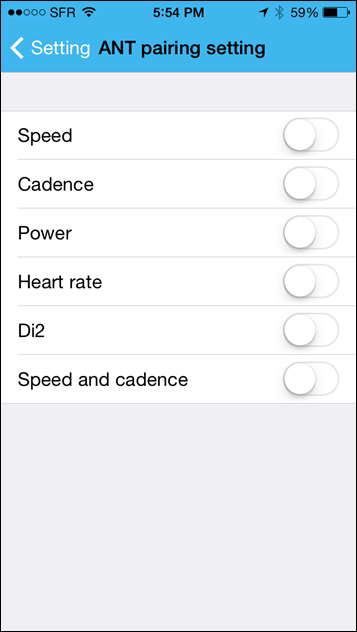
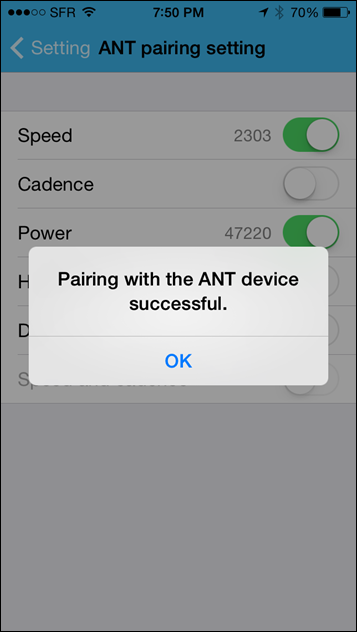
The unit also supports gathering Shimano Di2 shifting information if you have the ANT adapter for it, the SM-EWW01:
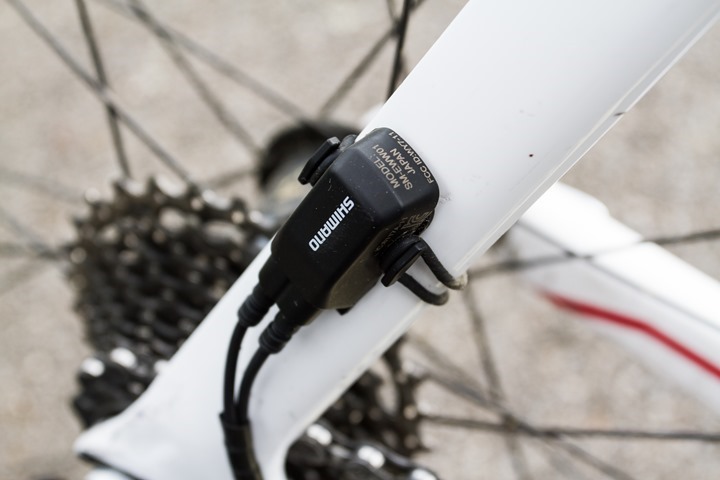
This little adapter will transmit information on ANT (technically not ANT+, as that’s public, and this is private to Shimano). It’s the same adapter that also works with the Garmin Edge 1000 as well as the Mio Cyclo 505HC. However, despite the adapter, and despite numerous and repeated attempts, the current firmware as of July 22nd won’t seem to pair to my Di2 system (my Edge unit pairs just fine).
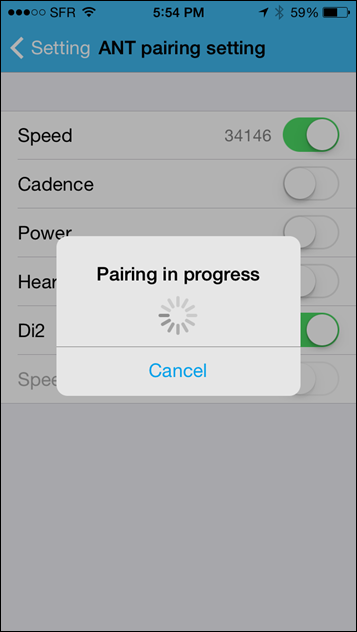
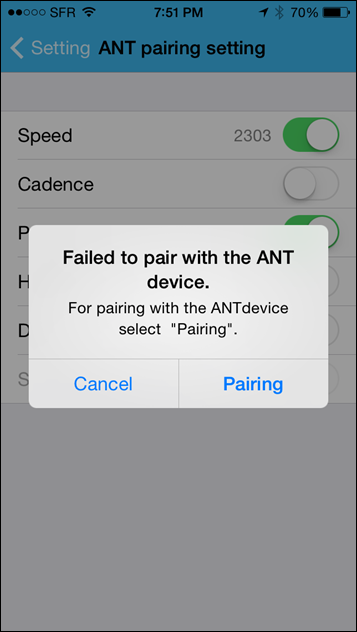
Hopefully that’s a temporary bug.
As for compatibility of sensor types, here’s what’s supported:
ANT+ Heart Rate Strap
ANT+ Speed-Only Sensor
ANT+ Cadence-Only Sensor
ANT+ Speed & Cadence Combo Sensor
ANT+ Power Meter
Shimano ANT Di2 with the SM-EWW01Note: It does NOT support any Bluetooth Smart sensors, nor Polar WIND sensors, nor anything else not ANT+.
As you can see below in a moment however, there are some quirks – for example it doesn’t pull cadence from the power meter (which virtually all devices do), so you’ll need to have a separate cadence sensor to get cadence.
When it comes to recording this data, Shimano has gone with a simplified route. For each and every video it produces a simple accompanying CSV file that lists the timestamp in 1-second increments along with the data from each sensor type:

So if you have a 5 minute video, you’ll have an accompanying CSV file for that five minute video. Each time you start recording you’ll get a new CSV file.

This system has pros and cons to it. For example, in the Garmin VIRB’s case you actually get two files – one for the entire ride and one for each video. Further, in that case those files are .GPX and .FIT files, which means that can actually be uploaded easily to sites like Strava and others. Meanwhile with Shimano it’s a bit more ‘open’, even if that openness doesn’t easily translate to secondary uses with sports files. It does however give you more flexibility though with 3rd party apps like Dashware, which can easily consume .CSV files. My understanding is at present Dashware does have a version of their software that’s compatible with the Shimano Action Cam, available upon request.
Finally, for those curious from a development perspective, I’ve placed a few quick sample files and super-short raw/original video clips here in a zip file (for just viewing some clips see later section below).
The Phone App:
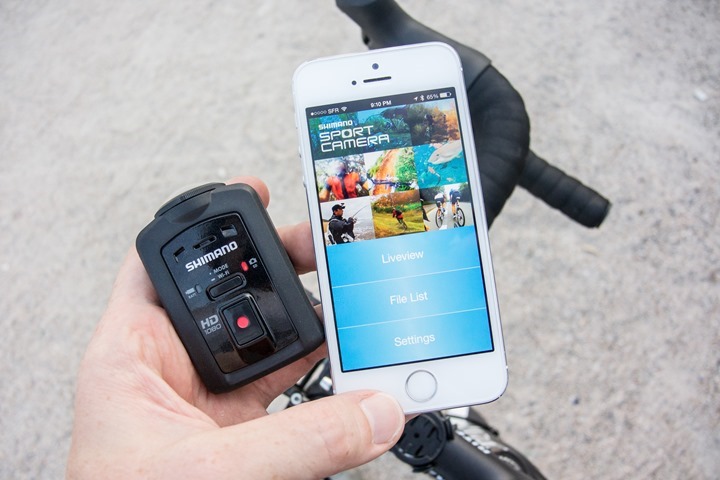
The CM-1000 includes connectivity to be controlled by a mobile phone app, which is available on both iOS and Android. This app uses WiFi to connect to the camera. To control the camera you’ll hold down the small button for a few seconds until both lights blink, which indicates WiFi is enabled. From there you can join the WiFi network from your phone:


Note that you can tweak the WiFi network name and password as described on Shimano’s site.
Once in the app you’ll see you have three options: Liveview, File List and Settings.

We’ll start with Live View, which allows you to control the camera, specifically, to start and stop the camera and view pairing information. The delay is very impressive, roughly 1-second at most:
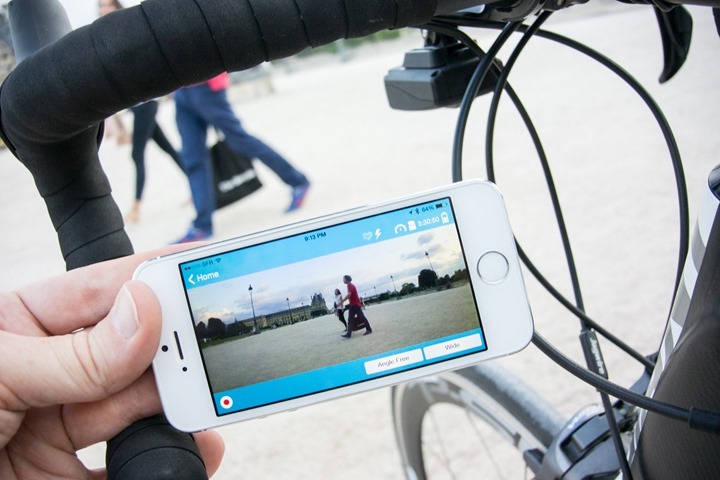
Below you can see the recording button, as well as the ability to quickly set Angle Free to enabled or disabled. Finally, there’s the option to toggle between the two field of views; wide (135°) and super-wide (180°). Below is wide:
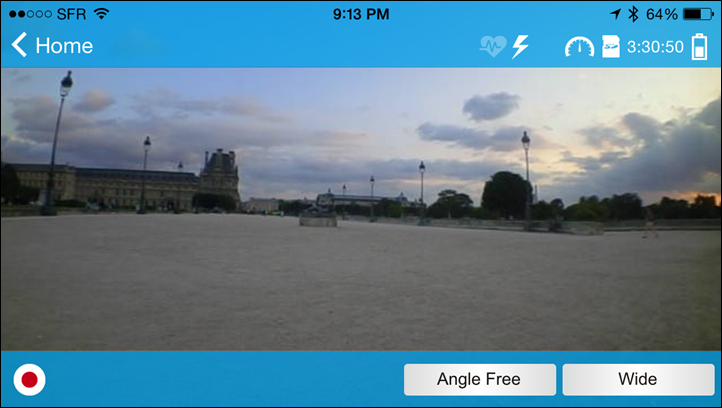
And here’s super-wide, which you can see now includes the hoods:
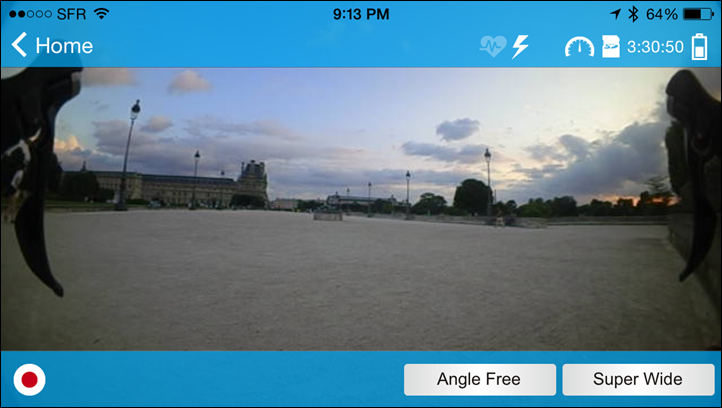
You’ll also note that at the top it’ll show recording time left on the SD card and battery state, as well as whether it’s connected to various ANT+ sensors at that point in time. I have noticed it seems a bit finicky when it comes to sustaining ANT+ sensor connectivity, but that may just be a transient fluke – it’s something I’ll be looking more closely at later on in my in-depth review.
Next, if we go back to the main menu we can change to ‘File List’, which allows you to list all files on the unit. This includes both photos and videos:
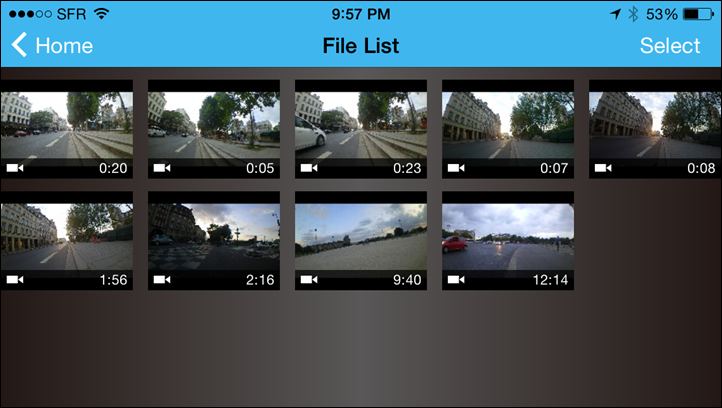
From here you can playback these files as well as save them to your phone. The transfer is a bit slow, so it does take a fair bit of time to save even the smallest clip. For example, this 20 second clip took just under a minute to transfer. Nonetheless, it beats units like the VIRB which can’t transfer at all.
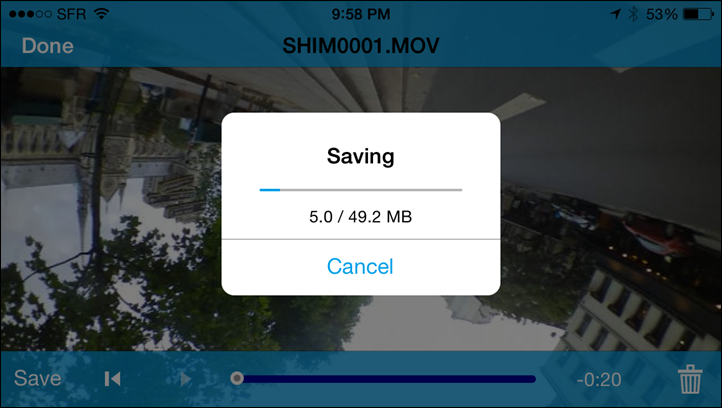
For the last mode we’ll dive into settings, which is where you can tweak everything on the camera.
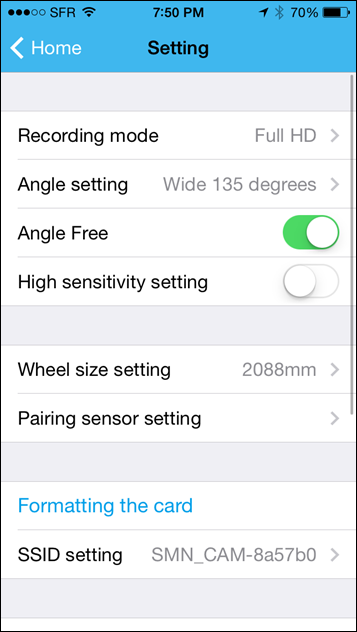
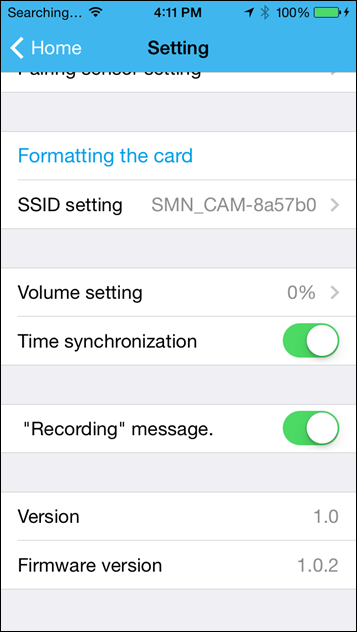
These changes are made instantly to the unit, and thus applicable immediately. Within the ‘Pairing Sensor Setting’ option, it simply takes you to the ANT+ sensor pairing area that I described in the previous section. Otherwise, what you see above is the full slew of settings available in the app today.
The Desktop App:
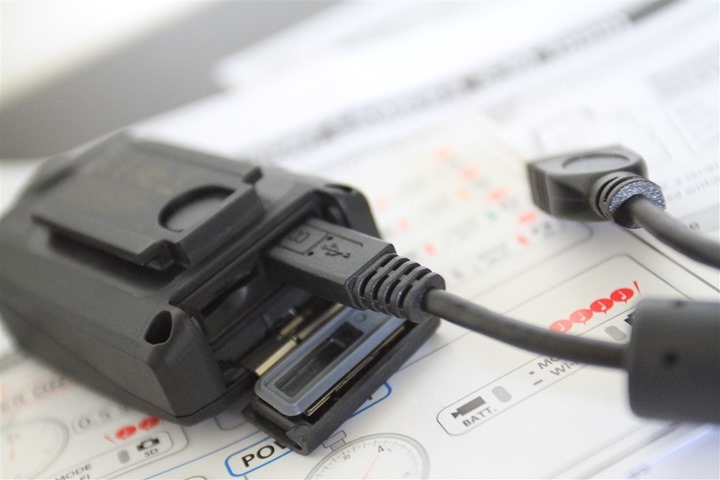
As of this writing the desktop app has yet to be released. The desktop app is critical though because it’s the piece of software that allows you to overlay gauges and other metrics from your ride. These metrics are the primary reason why you’d actually buy the Shimano Action Cam over other competitors. Without these gauges then there’s honestly very little reason to buy this over a GoPro (actually, there’s a lot of reasons why you shouldn’t). Thus, it comes as a bit of a surprise that this has to wait. It’ll be interesting to see how the desktop software looks upon release, and then what type of release/update cycle they get into.
In particular, it’ll be interesting to compare it to the Garmin VIRB Edit suite, which will compete with it from a gauges/overlay standpoint. In the case of Garmin, they’ve been releasing updates no fewer than every four weeks or so, including a major update recently and another major update planned shortly. They’ve actually added an incredible amount of functionality since last winter when I initially reviewed it. Thus it’ll be important for Shimano to have sustained development on it to remain competitive.
And finally, for those curious – no, the VIRB Edit suite won’t work with the Shimano action cam (I tried). It doesn’t read the video files produced by the action cam unfortunately. Nor can it read the native .CSV files produced by the action cam. One could however convert the video files using a 3rd party converter, as well as then use a .FIT file from a Garmin device though and merge that. But that’s an awful lot of work.
Some Sample Video:
Given this is an action camera, it sorta makes sense to actually show you some videos (and photos). Right now that means ‘plain’ videos without any fancy graphic overlays – because Shimano hasn’t released that desktop software yet to create those. But as part of my final review I’ll include many videos with that data, as well as dual videos with a GoPro and/or Garmin VIRB alongside things.
Video #1: A short ride around Paris: In this video I’ve mixed clips from a front and rear mounted camera to show the different views. In this case these were taken about an hour before sunset. It’s about 10 minutes long so feel free to just jump around. The first half is front facing, and second half rear-facing.
I’ll be adding more videos in the coming days as I use it more – so keep checking back.
Again, as part of my final in-depth review I’ll have a much more detailed look at videos and probably somehow make them slightly more exciting.
Tidbits That Didn’t Fit:
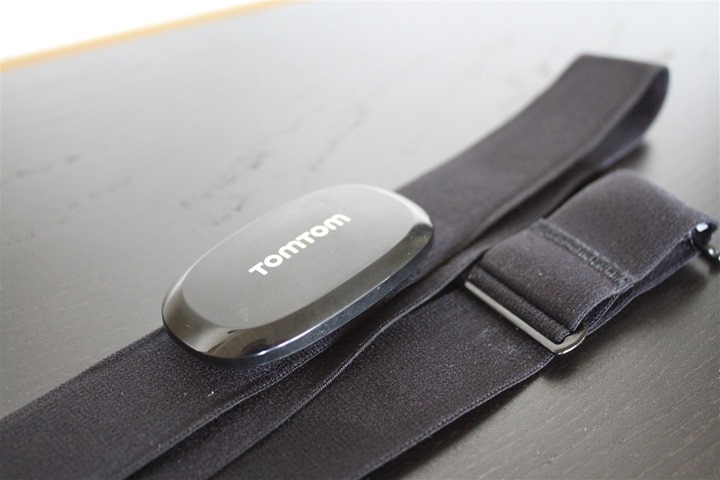
Here’s a small smattering of things that didn’t quite fit elsewhere in the post but I thought were worthwhile noting somewhere. Thus, they go here:
– The Max MicroSD card size is 32GB: This is kinda a big deal in a unit that lacks a remote control so you might otherwise just leave it running constantly while on a ride. It’s surprising they don’t support 64GB MicroSD cards, though perhaps it’s not a hardware limitation and could be supported down the road.
– You are unable to delete files from card when plugged into computer: Also in the ‘annoying camp’ is that the Shimano unit will write-protect the files on the card when plugged into a computer via USB. This means you can’t delete files off of it when you run out of space, unless you take the card out of the camera and place it separately in the computer.
– The mounting bracket isn’t a perfect fit: There’s a itty bitty bit of ‘play’ in between the mounting bracket and the camera. A fraction of a millimeter. But in the action camera world it’s this little bit of give/play that gives you vibrations and crappy video. There isn’t a way to lock this down, since it’s on the sliding part.
– I was unable to pair Shimano Di2: Despite my Edge 1000 easily pairing to my Di2 system via the Shimano SM-EWW01, the action camera would not. I tried on multiple attempts on different days and multiple times per day. No love. I suspect this is a temporary bug.
– WiFi is finicky: The unit will immediately drop the WiFi connection as soon as you lose focus on the app (so if you temporarily turn off the screen, or switch to another app). This is sorta annoying because you then have to re-connect to WiFi manually. It appears as soon as the app loses focus it sends a note to the unit to turn off WiFi remotely, which in turn disconnects everything. While I get the idea to potentially save battery, I want that to my my choice, not that of the of Shimano’s.
– Lack of zoom mode: One challenge is that while the wide-angle settings are great, there isn’t a zoom option. Zoom options can be useful when you’re trying to get ‘beyond’ an obstruction, such as the front of your wheel or the windowsill on an airplane. Most action cameras include such a mode, whereas the Shimano does not.
The good news is that all of these except the the mount should be easily fixed in firmware and app updates.
Comparison Chart:
As usual, here’s the comparison chart looking at the features between the cameras. I’ve selected the GoPro Hero3+ Black, the Garmin VIRB Elite, and the Shimano CM-1000 camera as the ones people are most likely to compare. But you can dive into the full action camera product comparison database to mix and match units as you see fit.
Copyright DC Rainmaker – Updated March 16th, 2016 @ 7:21 amNew Window
Price$299$299$399
AvailabilityJuly 2014GlobalDiscontinued
WiFi BuiltinYesYesYes
Bluetooth to PhoneNoNoNo
Recording LightYes (small)YesYes
GPS builtinNoYesNo
Altimeter builtinNoYes – BarometricNo
Water Resistant10mIPX7 (1 meter for 30 mins), separate 50m dive case available40m with included case
AccellerometerNoYesNo
Video Preview ScreenNoBuiltinAccessory
Recharges viaMicro-USBMini-USBMini-USB
Removable batteryNoYes / 2000 mAhYes / 1180 mAh
Recording Time2 Hours3 hours2 hours
Secondary attached batteryNoNoAccessory
Storage Card TypeMicroSD CardMicro-SDMicroSD Card
Maximum Card Size32 GB64 GB64 GB
Records 360* VideoNoNoNo
4KNoNo12/12.5/15 fps
2.7KNoNo24/25/30 fps
1440pNoNo24/25/30/48 fps
1080p30 fps30 fps24/25/30/48/50/60 fps
960pNo30/60 fps48/100 fps
720p120 fps30/60 fps48/50/60/100/120 fps
WVGA240 fps60/120 fps240 fps
Automatic Image RotationYesNoNo
Looping RecordingsTBDYesYes
Timelapse Mode (constructs timelapse video)NoYesNo (requires desktop software)
Internal MicrophoneYesYesYes
Megapixels6MP (2848*2136)Up to 16 MP (4664*3496)12MP
Timelapse Mode (photos on interval)10s, 20s, 30s, 60s2,5,10,30,60s0.5,1,2,5,10,30,60s
Burst ModeNoUp to 6 photos/secondUp to 30 photos/second
Continuous Shooting ModeNoNoYes
Concurrent w/video modeNoYesYes
Records 360* PhotoNoNoNo
Skiing ModeNoYesNo
Control from sport computerNoYesNo
ANT+ Sensor ConnectivityYesYesNo
ANT+ Profile TypesHeart Rate, Speed, Cadence, Power, Di2 ShiftingHeart Rate, Cadence, Temperature, PowerN/A
Overlays sport data on recordingAugust 2014Yes, via included desktop appsNo
App platforms availableiOS/AndroidIOS/ANDROID/WINDOWS PHONEiOS/Android/Windows Phone
Use as remote controlYesYesYes
Stream live video previewYesYesYes
Record video from cameraYesNoYes
Multi-camera live control/previewNoNo
App for computerAugust 2014VIRB EditGoPro Studio
Remote control button/keyNoYesYes
Diving caseNoYes, up to 50mIncluded
Head StrapYesYesYes
Helmet StrapYesYesYes
Handlebar/SeatpostNoYesYes
TripodNoYesYes
Suction CupNoYesYes
Chest HarnessNoYesYes
Wrist Strap/HousingNoYesYes
Roll BarNoYesYes
SurfboardNoYesYes
Curved AdhesiveNoYesYes
Flat AdhesiveNoYesYes
Adjustable Mounting ArmsNoYesYes
USB Connector TypeMicro-USBMini-USBMini-USB
Micro-HDMINoYesYes
Composite VideoAdapter AvailableAdapter Available
Audio 3.5mm Stereo MicNoAdapter availableAdapter available
Amazon LinkLinkLinkLink
Clever Training Link (Save 10% with DCR10BTF)LinkLinkN/A
Review LinkLinkLink
Next, here’s all the accessories that are compatible with the Shimano Action Cam, from a variety of companies (since Shimano has yet to produce any of their own yet). Most of these are from GoPro, because those are the ones that are natively compatible:
Copyright DC Rainmaker – Updated December 1st, 2014 @ 10:18 am
3DRobotics IRIS+ Multicopter 915Mhz (has GoPro mount)3DRobotics$750LinkLinkN/A
GoPole 26″ Transparent extension pole for GoProGoPole$40LinkLinkN/A
GoPole Compact Hand Grip for GoProGoPole$23LinkLinkN/A
GoPole Floating Hand Grip For GoProGoPole$30LinkLinkN/A
GoPole Telescoping Extension Pole for GoPro (17″-40″)GoPole$55LinkLinkN/A
GoPole Weather Resistant Softcase for GoPro CamerasGoPole$27LinkLinkN/A
GoPole Helmet ExtensionGoPole Helmet Extension$20LinkLinkN/A
GoPro 3-Way Grip/Arm/TripodGoPro$69LinkLinkLink
GoPro Grab Bag of MountsGoPro$11LinkLinkN/A
GoPro Handlebar/Seatpost/Pole MountGoPro$8LinkLinkLink
GoPro Head Strap Mount + QuickClipGoPro$20LinkLinkN/A
GoPro Jaws Flex Clamp MountGoPro$36LinkLinkN/A
GoPro Jaws Flex Gooseneck OnlyGoPro$20LinkLinkN/A
GoPro Roll Bar MountGoPro$16LinkLinkN/A
GoPro Side MountGoPro$7LinkLinkN/A
GoPro Suction Cup MountGoPro$26LinkLinkN/A
GoPro Surf MountsGoPro$11LinkLinkN/A
GoPro Tripod MountGoPro$10LinkLinkN/A
GoPro Vented Helmet Strap MountGoPro$7LinkLinkN/A
K-Edge Action Cam MountsK-EdgeVariesLinkLinkLink
Shimano SM-EWW01 Wireless Unit for Di2Shimano$79LinkLinkLink
Note that these charts do dynamically change over time with new accessories and/or features as cameras get updated.
Summary:
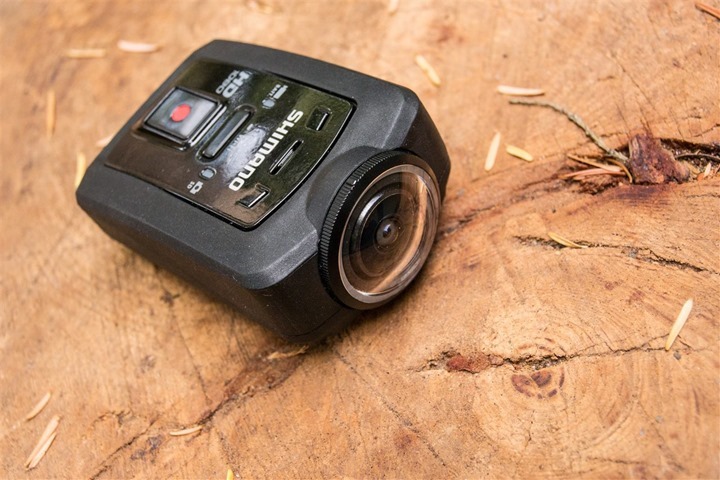
At first glance the Shimano action cam is a pretty interesting little creature. Its size is incredibly appealing, as is the inherent waterproofing. And finally the ANT+ sensor support has the potential to be a great addition allowing one to produce cool videos – especially in the cycling realm.
But that’s the current catch – there’s a lot of ‘potential’ right now. It will potentially have cool software released to make that sensor support come to life. They potentially could actually have mounts (both known and unknown) down the road. And they could potentially resolve many of the little software quirks/bugs. But it’s all speculative, and Shimano doesn’t exactly have any history in this segment to go on here to base guesses. So we don’t know if the software will be great or horrible, and we don’t know if the bugs will get worked out.
Thus, we’re left in a bit of a pickle. On one hand it’s a compelling unit, but on the other hand it’s basically lacking the components needed to justify why you’d buy it over the competition. Shimano says those components are coming later this summer – which is a core reason why I’m waiting for them for my full in-depth review. If they can deliver on those in a quality manner, then the CM-1000 will definitely be a solid contender come this fall.
So in the meantime I’d recommend either looking at the current offerings on the market and basing your purchasing decisions based on what’s there today (if you need a camera today), or waiting till the end of summer if you don’t need a camera immediately to see how things shake out.
Found this preview useful? Or just wanna save a bundle of cash? Here’s how:
Hopefully you found this review useful. At the end of the day, I’m an athlete just like you looking for the most detail possible on a new purchase – so my review is written from the standpoint of how I used the device. The reviews generally take a lot of hours to put together, so it’s a fair bit of work (and labor of love). As you probably noticed by looking below, I also take time to answer all the questions posted in the comments – and there’s quite a bit of detail in there as well. 
I’ve partnered with Clever Training to offer all DC Rainmaker readers an exclusive 10% discount across the board on all products (except clearance items). You can pickup the Shimano Action Cam below. Then receive 10% off of everything in your cart by adding code DCR10BTF at checkout. By doing so, you not only support the site (and all the work I do here) – but you also get a sweet discount. And, since this item is more than $75, you get free US shipping as well.
Shimano CM-1000 Action Camera
Additionally, you can also use Amazon to purchase the action cam or accessories (though, no discount). Or, anything else you pickup on Amazon helps support the site as well (socks, laundry detergent, cowbells). If you’re outside the US, I’ve got links to all of the major individual country Amazon stores on the sidebar towards the top.
Thanks for reading! And as always, feel free to post comments or questions in the comments section below, I’ll be happy to try and answer them as quickly as possible.











